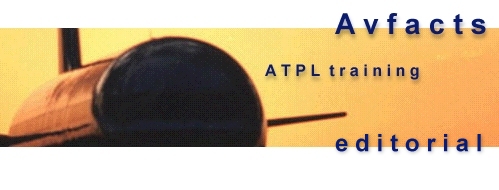




 |
 |
  |
 |
Aircraft Systems Topic 10.
Ice Protection Systems
| General
Modern airliners over 5, 700 kg are fitted with ice protection systems that allow operations in areas of known icing. As you are probably aware by recent accidents such as that of an ATR 72 in America, these systems cannot always protect against particularly severe icing conditions, and so you should treat ice with the considerable respect it deserves. In this mini editorial we will deal with the types of ice protection systems used on turbojet aircraft. First though you must know that there are two types of ice protection systems, namely “DE-ICE” and “ANTI-ICE”.De-Ice Anti-ice
Electric anti-ice Thermal Anti-Ice This in turn reduces aircraft acceleration, takeoff performance, speed, climb ability, and altitude capability. Wing anti-ice causes a larger performance reduction than that caused by heating of the relatively small engine nacelle areas. It should be noted that engine intake icing can occur well above zero degrees centigrade, as air entering the engine accelerates and cools due to the convergent duct formed at that point. Typically aircraft flight manuals will specify the use of anti-ice on these surfaces when operating in the presence of visible moisture, with outside air temperatures of +10C or less. For those aircraft such as the Fokker F28 whose engines feature inlet nozzle guide vanes, these to will be supplied hot air to prevent ice build up. If ice is allowed to build up in the engine intakes, then is dislodged, it can cause engine damage. The fuel tanks are NOT heated as the freezing point of Jet A1 is approximately -50C. Fuel enroute to the engines is heated by way of a fuel/oil heat exchanger, which serves the double purpose of cooling engine and hydraulic oil also. Fluid de-ice Effect of icing on Top of Descent point I hope that this mini training editorial helps you in your studies. Further Airline Pilot training texts such as these are available at most pilot supply shops around Australia, or through the secure ONLINE SHOP at this website for those of you with plastic money. A list of approved distributors is available within the Avfacts site. ATPL training course information is also available within the Avfacts website. Finally, good luck with your studies, and remember ... “Pilot’s have a smoother approach”! Best Wishes Rob Avery
|
![]()